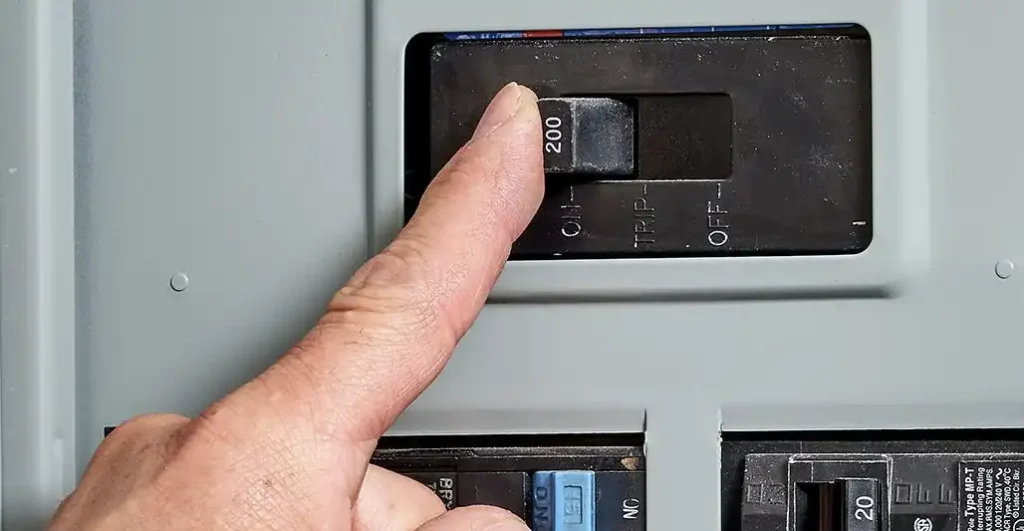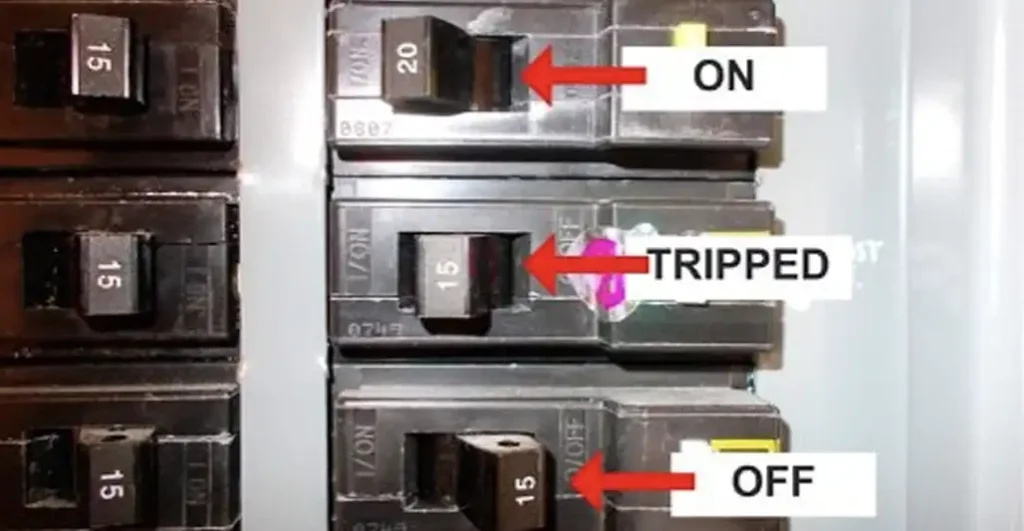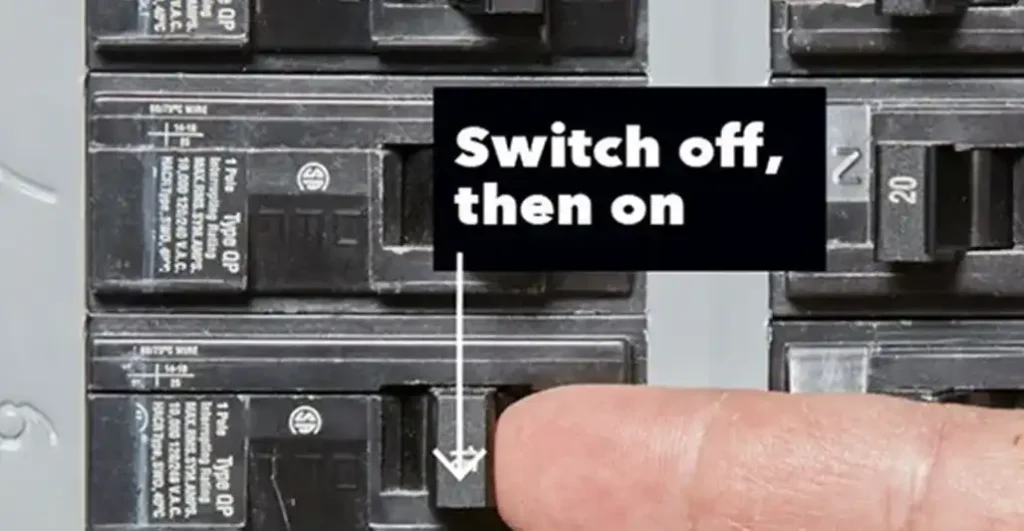In everyday life, we encounter situations where turning off a circuit breaker becomes necessary for various reasons. Whether it’s for safety during electrical work or to reset a tripped breaker, knowing how to properly turn off a circuit breaker is essential knowledge.
In this guide, we’ll delve into the step-by-step process of turning off a circuit breaker in English, ensuring safety and clarity throughout.
Importance of Turning Off Circuit Breakers

The importance of turning off circuit breakers cannot be overstated, as it plays a crucial role in ensuring safety, protecting electrical devices, and preventing potential hazards. Let’s delve deeper into why turning off circuit breakers is essential:
Safety:
One of the primary reasons for turning off circuit breakers is to ensure safety, both for individuals working on electrical systems and for occupants of the building. When a circuit breaker is switched off, it interrupts the flow of electricity to a specific circuit, reducing the risk of electrical shocks and accidents. This is particularly important during maintenance, repairs, or installations, where exposure to live electrical currents can be hazardous.
Protection of Electrical Devices and Appliances:
Turning off circuit breakers helps protect electrical devices and appliances from damage. In the event of a power surge or fluctuation in voltage, such as during a lightning storm or utility grid issue, cutting off power to affected circuits prevents these devices from being overwhelmed by excessive electricity. This safeguards sensitive electronic equipment, such as computers, TVs, and home appliances, from potential harm.
Prevention of Fires:
Faulty electrical systems can pose a significant fire hazard if left unchecked. By promptly turning off circuit breakers when issues arise, such as overheating wires, short circuits, or overloaded circuits, the risk of electrical fires can be mitigated. Interrupting the flow of electricity prevents the conditions that could lead to overheating and ignition, thereby enhancing overall fire safety in residential, commercial, and industrial settings.
Facilitation of Maintenance and Repairs:
Turning off circuit breakers is a necessary step before conducting any electrical maintenance or repairs. Whether replacing a light fixture, installing new outlets, or troubleshooting electrical issues, cutting off power at the circuit breaker ensures a safe working environment for electricians, homeowners, and DIY enthusiasts. It eliminates the possibility of accidental contact with live wires, reducing the likelihood of injury and property damage.
Energy Conservation:
While not directly related to safety, turning off circuit breakers can contribute to energy conservation and cost savings. By powering down circuits that are not in use, such as lights in unoccupied rooms or appliances on standby mode, unnecessary electricity consumption is avoided. This aligns with sustainable practices and helps reduce utility bills over time.
Types of Circuit Breakers
Single-Pole Circuit Breakers
These are the most common type of circuit breakers found in residential electrical panels. They control individual circuits and are typically rated for 120 volts.
Double-Pole Circuit Breakers
Double-pole breakers are used for larger appliances and systems, such as air conditioners or electric water heaters. They are rated for 240 volts and protect both hot wires.
How to Turn Off Circuit Breaker

Let’s provide a comprehensive step-by-step guide on how to turn off a circuit breaker safely and effectively:
Identify the Electrical Panel:
Locate the main electrical panel in your home or building. It is usually found in a utility room, garage, or basement. The panel contains circuit breakers or fuses that control the flow of electricity to various circuits throughout the building.
Ensure Safety Precautions:
Before proceeding, prioritize safety by wearing insulated gloves and safety goggles to protect against potential electrical hazards. If unsure about safety procedures or uncomfortable working with electricity, consider consulting a qualified electrician.
Access the Electrical Panel:
Open the door or cover of the electrical panel by unscrewing or flipping the latch. Exercise caution and avoid touching any exposed wires or components inside the panel.
Locate the Circuit Breaker:
Inside the electrical panel, you will find rows of circuit breakers arranged vertically or horizontally. Each breaker controls a specific electrical circuit in the building. Take note of the labels or markings on the breakers to identify the circuit you wish to turn off.
Switch Off the Circuit Breaker:
To turn off a circuit breaker, locate the corresponding breaker switch for the circuit you want to deactivate. Move the switch from the “on” position to the “off” position by firmly pushing it in the opposite direction. You may hear or feel a click as the switch moves.
Verify Power Shutdown:
After switching off the circuit breaker, verify that power to the designated circuit has been successfully shut down. Test the affected outlets, lights, or appliances to ensure they are no longer receiving electricity. Use a non-contact voltage tester to confirm that the circuit is de-energized before proceeding with any work.
Proceed with Maintenance or Repairs:
With the circuit breaker turned off and power to the circuit safely disconnected, you can now proceed with maintenance, repairs, or installations. Whether replacing a light fixture, installing a new outlet, or troubleshooting electrical issues, work confidently knowing that the circuit is safely deactivated.
Record Your Actions:
As a safety precaution and for future reference, consider keeping a record of which circuit breakers were turned off and for what purpose. This can be helpful when troubleshooting electrical problems or conducting routine maintenance in the future.
Restore Power:
Once the maintenance or repairs are completed, return to the electrical panel and switch the circuit breaker back to the “on” position. This restores power to the circuit, allowing normal operation of electrical devices and appliances.
Close the Electrical Panel:
After ensuring that all work is complete and power has been restored, securely close the door or cover of the electrical panel. Tighten any screws or latches to prevent unauthorized access and protect against accidental contact with live electrical components.
Following these step-by-step instructions will help you safely and confidently turn off circuit breakers when needed, promoting a secure working environment and minimizing the risk of electrical accidents or injuries.
Is It Safe to Turn Off Circuit Breaker
Yes, it is safe to turn off a circuit breaker when done correctly and for the appropriate reasons. Turning off circuit breakers is a standard safety practice recommended in various situations, such as:
- Electrical Maintenance and Repairs: When performing maintenance or repairs on electrical systems, turning off circuit breakers is essential to ensure the safety of individuals working on or near live electrical components. This helps prevent electrical shocks, burns, and other accidents.
- Resetting Tripped Breakers: If a circuit breaker has tripped due to overload or a short circuit, it is safe to turn off the breaker to reset it. This allows you to investigate the cause of the trip and address any underlying issues before restoring power to the circuit.
- Emergency Situations: In the event of an electrical emergency, such as a fire or other hazard involving electrical equipment, turning off circuit breakers can help prevent further damage and mitigate risks. Cutting off power to affected circuits can aid in containing the situation until professional assistance arrives.
- Energy Conservation: Turning off circuit breakers for circuits that are not in use or for devices that consume standby power is a safe and effective way to conserve energy and reduce electricity costs. This practice also helps extend the lifespan of electrical appliances and equipment.
While turning off circuit breakers is generally safe, it’s essential to follow proper procedures and safety precautions to minimize risks. This includes wearing appropriate personal protective equipment, such as insulated gloves and safety goggles, and ensuring that power is completely shut off before working on electrical systems. If unsure or uncomfortable with the process, it’s advisable to seek assistance from a qualified electrician.
How to Turn on Circuit Breaker

Turning on a circuit breaker is a straightforward process, but it’s important to follow proper procedures to ensure safety and effectiveness. Here’s a step-by-step guide on how to turn on a circuit breaker:
Locate the Electrical Panel:
Begin by locating the main electrical panel in your home or building. This panel contains the circuit breakers or fuses that control the flow of electricity to different circuits throughout the building.
Access the Electrical Panel:
Open the door or cover of the electrical panel by unscrewing or flipping the latch. Exercise caution and avoid touching any exposed wires or components inside the panel.
Identify the Circuit Breaker:
Inside the electrical panel, you’ll find rows of circuit breakers arranged vertically or horizontally. Each breaker controls a specific electrical circuit in the building. Locate the circuit breaker that corresponds to the circuit you wish to activate.
Check the Breaker Position:
Before turning on the circuit breaker, check its current position. The breaker switch should be in the “off” position, which is typically indicated by being in the middle or opposite direction from the “on” position.
Turn on the Circuit Breaker:
To turn on the circuit breaker, firmly push the breaker switch from the “off” position to the “on” position. You may hear or feel a click as the switch moves into place. Ensure that the switch is securely in the “on” position.
Verify Power Restoration:
After turning on the circuit breaker, verify that power has been restored to the designated circuit. Test the outlets, lights, or appliances connected to the circuit to ensure they are receiving electricity. You can use a voltage tester or plug in a device to confirm power availability.
Monitor for Issues:
Once power has been restored, monitor the circuit for any signs of abnormalities or malfunctions, such as flickering lights or sparking outlets. If you notice any issues, immediately turn off the circuit breaker and consult a qualified electrician for further inspection and repairs.
Secure the Electrical Panel:
After ensuring that the circuit is functioning properly, securely close the door or cover of the electrical panel. Tighten any screws or latches to prevent unauthorized access and protect against accidental contact with live electrical components.
By following these steps, you can safely and effectively turn on a circuit breaker, restoring power to the designated circuit and enabling the operation of electrical devices and appliances.
Conclusion
In conclusion, knowing how to turn off a circuit breaker is a fundamental skill for homeowners and professionals alike. By following the steps outlined in this guide, you can safely manage your electrical systems and avoid potential hazards.




















